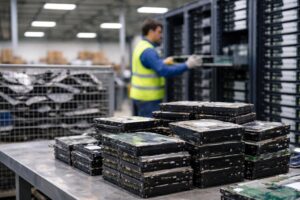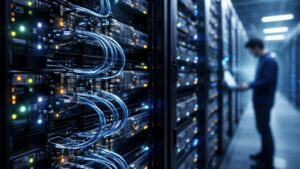Today, digital transformation is reshaping industries. Amongst this transformation, the energy footprint of data centers stands to be a major concern. At the heart of this challenge lies data center networking. It is a complex ecosystem that underpins the seamless flow of information. Furthermore, as organizations strive to balance the demand for data with sustainability, innovative approaches are emerging in it. This article talks about the strategies and technologies of efficient data center networking. So, it will help not only in optimizing the network performance but in a sustainable future as well. So, let’s dive in.
Software-Defined Networking (SDN) for Energy Efficiency
Software-defined networking has emerged as a game-changer in the quest for energy-efficient data center networking. Network administration can now be more flexible and efficient thanks to SDN. This is by separating the network control plane from the data plane.
Dynamic Traffic Routing and Load Balancing
The ability of SDN to dynamically route traffic and balance loads across the network is a major advantage in terms of energy efficiency. Static routing protocols can result in the wasteful use of network resources and higher energy costs. They are the foundation of traditional networking,
Network managers can use intelligent traffic routing algorithms. These can take into account the current state of the network using SDN. For instance, SDN can combine data flows onto fewer network channels during times of low traffic. As a result, it enables unused switches and routers to be turned off or placed in low-power modes.
SDN load balancing employs more sophisticated techniques. To decide on the best load-balancing strategy, advanced SDN controllers examine data. This examination is on energy usage, application needs, and traffic trends. As a result, the network performs better and the network architecture uses energy more effectively.
Network Virtualization and Resource Consolidation
SDN-enabled network virtualization makes it possible to create many logical networks on a single physical infrastructure. This capacity allows for improved resource consolidation and utilization. It is beneficial for energy efficiency.
Data center operators can minimize the quantity of physical networking equipment needed by virtualizing network services. Furthermore, firewalls, load balancers, and intrusion detection systems can be virtualized. It can also be operated on shared hardware in place of specialized hardware. The network infrastructure’s overall energy footprint is decreased by this consolidation.
More precise control over resource allocation is also possible with SDN-enabled network virtualization. Network managers can distribute processing power and bandwidth. This is according to the unique requirements of various tenants or applications. This degree of control makes sure that resources aren’t squandered on excessive provisioning. As a result, it promotes processes that use less energy.
Automated Power Management
The centralized control plane of SDN offers a network-wide framework. It is useful for the deployment of automated power management techniques. Furthermore, these techniques can cut energy use dramatically. It also doesn’t sacrifice the dependability or performance of the network.
Adaptive link rate (ALR) is one tactic that modifies network link data rates dynamically in response to traffic demand. Moreover, links can function at slower speeds and use less power when utilization is low. Additionally, all connections will run at the most energy-efficient rate for the traffic conditions at hand. This is thanks to the network-wide implementation of ALR regulations by SDN controllers.
Idle network components can be turned off or put into sleep mode using another approach made possible by SDN. To turn off superfluous switches, ports, or even entire network segments, the SDN controller can keep an eye on how the network is being used. When traffic grows, these components may be swiftly brought back up.
Artificial Intelligence and Machine Learning in Network Optimization
The integration of AI and ML into data center networking is increasing its potential for energy efficiency. With the help of these technologies, network management may become predictive and adaptive. This can drastically cut down on energy use. It is also one of the best energy-efficient strategies for data centers.
Predictive Traffic Analysis and Capacity Planning
Predictive analytics driven by AI has the potential to completely change how data center networks manage traffic and capacity planning. Furthermore, AI systems can precisely predict future network demands. This is by examining past traffic patterns.
Network managers can proactively modify network resources to match expected demand owing to these predictive capabilities. Suppose artificial intelligence (AI) forecasts a surge in traffic during specific hours. In that case, more network capacity may be added precisely when needed, instead of continuously using excess capacity.
AI-driven capacity planning can also aid in the optimization of equipment purchases and network layout. Artificial intelligence can suggest the most energy-efficient network designs. This is by modeling various network setups and traffic situations. So, this might involve recommendations for network node location. It can also involve topology modifications, or even equipment improvements to reduce energy usage.
Anomaly Detection and Self-Healing Networks
The detection of abnormalities in complex systems, such as data center networks, is a specialty of ML algorithms. ML models can identify odd trends that can point to inefficiencies or possible problems. This is by continually monitoring network performance indicators.
Often, energy inefficiencies manifest as abnormalities in network performance. For example, an inoperative switch might result in higher-than-normal power consumption. It can also cause inefficient traffic routing. Such problems may be promptly identified using ML-based anomaly detection. As a result, it will enable timely resolution and avert extended periods of energy loss.
Additionally, the idea of AI and ML-powered self-healing networks is becoming more popular. When abnormalities or failures are recognized, these networks can automatically rearrange themselves. Moreover, self-healing networks swiftly reroute traffic around damaged network parts. This is to preserve maximum performance and energy economy.
Intelligent Cooling and Power Management
AI and ML are essential for controlling the physical infrastructure of data center networks. AI-driven intelligent cooling systems can accurately regulate the temperature surrounding data center networking equipment. As a result, it lowers the amount of energy required for cooling making it one of the most impactful energy-efficient strategies for data centers.
ML algorithms can generate an extensive thermal map of the data center. This is done by analyzing data from power consumption meters, airflow monitors, and temperature sensors. With this data, cooling systems may be dynamically adjusted. This is to provide the precise amount of cooling that each network infrastructure component requires.
Additionally, AI can optimize power distribution to data center networking equipment in power management. This is done by using efficiency and utilization measurements that are updated in real-time. AI-controlled power distribution units (PDUs), for instance, can distribute power among network racks more effectively. It possibly requires the usage of fewer power supplies and lower total energy consumption.
Energy-Efficient Network Hardware and Architectures
The physical design and hardware of data center networks are important for improving energy efficiency in networking. Advancements in network hardware and architecture are pushing the limits of energy-efficient data center networking.
Low-Power Network Switches and Routers
Hardware makers have made developing low-power network switches and routers a top priority. Compared to their predecessors, these gadgets are made to work well while using a lot less energy.
The adoption of application-specific integrated circuits (ASICs) designed with networking duties in mind is one technological advancement propelling this trend. These specialized chips need less power. This is because they are more effective at packet processing and forwarding tasks than general-purpose CPUs.
The addition of power-saving modes to network switches is another innovation. For instance, when a port is not delivering data, Energy Efficient Ethernet (EEE) permits it to go into a low-power idle mode. Without affecting the responsiveness of the network, this can lower power consumption on idle lines by up to 70%.
Additionally, several manufacturers are looking at using different materials and designs to increase energy efficiency. For example, using gallium nitride (GaN) in the power supply can cut cooling needs for network equipment. This is by increasing efficiency and reducing heat generation.
Optical Networking and Photonic Integration
Energy efficiency is a major benefit of optical networking technology. This is particularly true for high-bandwidth, long-distance connections inside data centers. Optical networking utilizes less power per bit delivered as compared to traditional copper-based connections.
Photonic integrated circuits (PICs) are enabling photonics to advance optical networking. This is by integrating optical components onto a single chip. . It lowers power consumption and increases density. With the use of this technology, small, fast network switches can be made. The ones that use a small percentage of the energy of their electronic equivalents.
Specifically, silicon photonics is beginning to show promise as an energy-efficient data center networking approach. Silicon photonics allows for low-power, high-speed, low-latency communication. This is by directly integrating optical components onto silicon devices. This technology is especially beneficial for rack-to-rack and inter-data center connectivity.
Disaggregated and Modular Network Architectures
Disaggregated and modular network designs are replacing traditional monolithic network architectures. This is because they provide more flexibility and energy efficiency. The hardware and software components of a disaggregated network are separated. It enables more precise control and optimization.
The usage of white-box switches running open-source network operating systems is one illustration of this trend. By configuring these switches to only operate the functions required for a given application, extraneous processing and power consumption can be avoided.
Data center operators can achieve greater energy efficiency by accurately scaling their networks. This is with the use of modular network designs. Operators can install smaller, modular units in place of large, fixed-capacity switches when they require more capacity. This method guarantees that every component runs as efficiently as possible while minimizing idle capacity.
To Sum Up
The push for energy-efficient data center networking is crucial for a sustainable digital future. It’s not just about technology—it’s a significant step toward sustainability. We’ve seen that using software-defined networking, artificial intelligence, and efficient hardware can greatly cut down on energy use.
Industry professionals can learn more at the Energy Efficiency for Data Centers Summit Asia on September 5-6, 2024, in Singapore. Innovators, decision-makers, and experts get together to talk about the newest developments in data center energy efficiency at this event. Attendees can network with leaders, learn from colleagues, and investigate strategies to improve the energy efficiency of their buildings. The primary objectives of the summit are to improve operations and sustainability while lowering energy costs and emissions. So, don’t pass up this opportunity to take part in this important event; register today!




